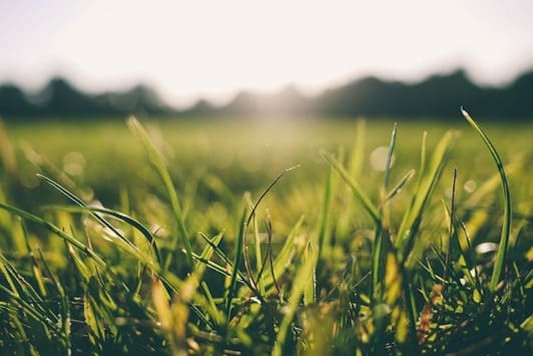What care does your lawn need in spring? In this post, we'll explain it to you.

Do you hear that?
It's the grass in your garden, stretching and waking up after its long winter slumber.
It's no joke!
With the arrival of spring, many plants that had been "sleeping" due to the cold weather wake up and grow more vigorously, and the lawn is no exception.
But to keep it healthy and green, you need to pay attention to a series of basic care tasks.
Tasks like the ones we'll explain in this post.
Grab your gloves and tools, we have a lot of work to do.
[Spring Lawn] The main tasks to prepare your lawn for the arrival of warmth
Depending on the condition of your lawn, it will require different maintenance. However, these are some of the most common tasks during spring.
1. Do you have weeds in your lawn? The first thing is to get rid of them
Weeds are one of the main threats to the lawn in spring.
These invasive plants compete with the grass for nutrients, water, and sunlight, which can weaken it and make it more vulnerable to diseases and pests.
There are several methods to eliminate weeds from the lawn, such as:
- Pulling them manually: but be sure to pull them out by the root; otherwise, they will grow back.
- Using selective herbicides: that kill weeds without harming the grass.
This is just a summary, but in this article, we give you several keys to eliminate weeds from your garden.
2. Aeration and scarification (give your lawn oxygen)
Aeration and scarification are two important techniques to keep the lawn healthy and green.
Aeration involves puncturing the soil with small holes to allow air, water, and nutrients to better penetrate the grass roots.
Scarification, on the other hand, involves scraping the surface of the lawn to remove the layer of felt and dead organic matter (the famous "thatch") that accumulates on the surface.
Both techniques will help oxygen and water infiltrate the soil and reach the grass roots.
And that means it will grow healthier and stronger.
3. Reseed areas with low grass density
After winter, there may be bald patches or areas with low grass density in our garden. This may be due to various causes, such as:
- The usual transit of people and/or animals.
- The lack of sunlight.
- The excess of moisture.
To solve this problem, it is necessary to reseed those areas with new grass.
For this, it is important to prepare the soil well, removing weeds and aerating the soil. Then, spread the grass seed and cover with a thin layer of soil or sand.
It is advisable to water frequently and keep the soil moist until the new seeds germinate and establish themselves.
4. Apply some fertilizer for your grass to grow healthy
Spring is the ideal time to apply fertilizer to the grass.
After a long and cold winter, the grass needs nutrients to grow strong and healthy. A balanced and slow-release fertilizer will provide the nutrients it needs to develop properly.
But be careful! You have to apply the right amount (following the manufacturer's instructions). An excess of fertilizer can burn the grass roots.
5. Mow regularly
During spring, the grass begins to grow at a faster rate, as it comes out of winter dormancy. And that means you'll have to mow it more regularly.
How often?
Well, it will all depend on how fast it grows (different grass varieties will grow at different speeds).
But as a reference, the usual thing is to mow about once a week.
Remember not to mow more than a third of the blade, so that the grass can maintain nutrients and water and continue to grow normally.
6. Adjust the irrigation to your garden's needs
The weather during spring can vary a lot.
And it's important to adjust the irrigation to the grass's needs.
Make sure to offer enough water for it to grow healthy, but avoid overwatering to prevent drowning the grass roots.
In addition, as the heat increases, it will be best to advance the irrigation to the early hours of the morning. This way:
- The grass will have enough time to absorb the water before it evaporates.
- You will avoid the drops creating a "magnifying glass effect" with the midday sunlight, which could burn the leaves.
- You won't run the risk of the grass remaining wet for too long (as it would if you watered at night), which could promote the appearance of fungi and diseases.
If you can, it's best to install an automatic irrigation system to take care of it.
You now know the main care your grass will need this spring
We hope this article has been useful and helps you provide your grass with the care it needs.
Remember that if you have any questions, you just have to get in touch with us.
We will be happy to help you keep your lawn (and other plants) healthy and happy.

 English
English Spanish
Spanish